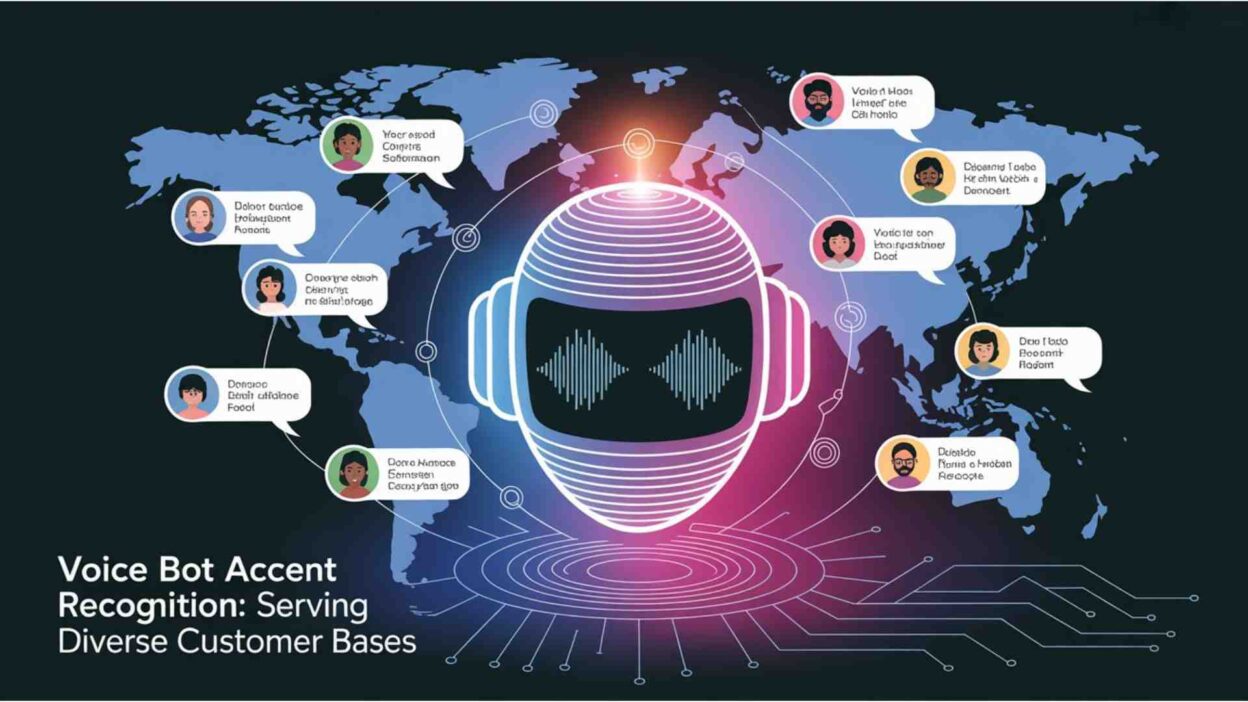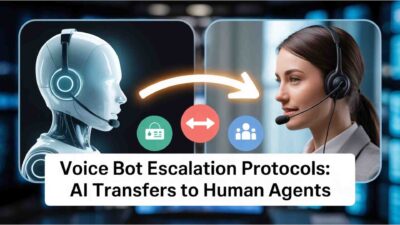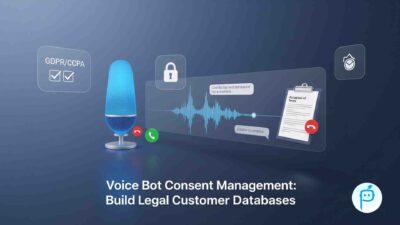The Critical Need for Voice Bot Accent Recognition
Global businesses face a major challenge today. Customers speak with diverse accents and dialects. Traditional voice systems struggle to understand linguistic variations. This creates frustration and lost revenue opportunities.
Table of Contents
English alone has over 160 distinct regional accents. Spanish, Arabic, and Mandarin show even greater variation. A customer from Edinburgh sounds different from someone in Chennai. Standard voice recognition systems often fail these interactions.
Research reveals a stark reality. 73% of customers abandon service interactions when their speech patterns aren’t understood. This represents millions in potential lost revenue. Modern businesses cannot afford this communication gap.
Voice bot accent recognition technology solves this critical problem. These systems understand cultural context behind different speech patterns. They enable truly inclusive customer service experiences.
Advanced Technology Behind Voice Bot Accent Recognition
Neural Network Architecture
Deep learning neural networks form the foundation. These networks train on massive datasets containing millions of speech samples. They learn phonetic patterns from diverse linguistic backgrounds. They identify intonation variations and pronunciation differences.
The system distinguishes between a Boston accent and Southern American speech. “Car” sounds like “cah” in Boston. The same word becomes “cawr” in the South. The system understands both variations perfectly.
Contextual Language Processing
Advanced systems go beyond individual word recognition. They employ sophisticated language models that understand context. This helps disambiguate similar-sounding words across different accents.
The system can distinguish between “can” and “can’t” clearly. Accent variations might make pronunciation less clear. Contextual analysis solves this challenge effectively.
Real-Time Adaptation
Voice bot accent recognition systems adapt during conversations. They learn specific speech patterns as they interact. They understand pronunciation tendencies and communication styles. Accuracy improves throughout each conversation.
This creates more natural interactions. The system becomes better at understanding individual customers. Each conversation builds on previous learning.
Regulatory Compliance in Multilingual AI Phone Support
Disclosure Requirements
AI-powered customer service systems must identify themselves clearly. This disclosure must be prominent across different linguistic communities. The system should announce its AI nature at every interaction start.
Cultural appropriateness matters in these disclosures. Different communities have varying communication expectations. The system must respect these differences while maintaining compliance.
Consent and Opt-Out Mechanisms
Customers must have clear options to speak with humans. Voice bot accent recognition systems must recognize opt-out requests universally. A “no” in a Scottish accent should be immediately recognized.
Standard American pronunciation shouldn’t receive preferential treatment. All accent variations deserve equal recognition and respect.
Data Protection Requirements
Voice bot accent recognition systems process biometric data. Speech patterns and accent characteristics are highly personal. This data requires strict protection according to privacy regulations.
GDPR in Europe sets strict standards. CCPA in California imposes similar requirements. Systems must implement appropriate safeguards for data transfers. Secure storage of voice data is mandatory.
Business Impact of Multilingual AI Phone Support
Customer Experience Improvements
Companies see 25-40% improvement in satisfaction scores. Customers feel genuinely understood regardless of linguistic background. First-call resolution rates increase by 20-35%.
Voice bots understand customer inquiries from the outset. This eliminates frustrating repetition and clarification cycles. Customers appreciate this immediate understanding.
Operational Efficiency Gains
Voice bot accent recognition reduces human agent escalations by 30-50%. This translates to lower operational costs immediately. Response times improve significantly across all customer segments.
Human agents can focus on complex issues requiring judgment. Voice bots handle routine inquiries across diverse linguistic communities. This creates optimal resource allocation.
Market Expansion Opportunities
Robust accent recognition enables confident geographic expansion. Companies report 40-60% faster market entry rates. Local speech patterns and cultural norms get understood automatically.
Businesses can serve new markets without extensive localization. The technology adapts to regional communication preferences. This accelerates international growth significantly.
Revenue Impact
Financial benefits are substantial and measurable. Companies report 15-25% increases in customer retention rates. Cross-selling success rates improve by 20-30%.
Customers who feel understood become more loyal. They remain receptive to additional services. This drives long-term revenue growth consistently.
Implementation Strategies for Diverse Customer Service
Phase 1: Customer Base Analysis
Businesses must analyze customer demographics thoroughly. This includes identifying primary accents and dialects. Peak calling times across regions need mapping. Cultural communication preferences require understanding.
Existing call data reveals speech patterns. Customer surveys show preferences for AI versus human interaction. Geographic distribution mapping uncovers linguistic diversity.
Phase 2: Technology Selection
Choosing the right platform is crucial for success. Leading platforms handle multi-jurisdictional compliance automatically. They provide sophisticated accent recognition capabilities. Integration with existing systems must be seamless.
Key evaluation criteria include accuracy across diverse accents. Compliance with local regulations is mandatory. Scalability for future growth is essential.
Phase 3: Training and Customization
Advanced systems require customization for specific business contexts. Industry-specific terminology needs training. Cultural context responses require customization. Escalation procedures need establishment.
Quality assurance protocols ensure consistent performance. Monitoring systems track accuracy across accent groups. Continuous improvement processes refine system responses.
Phase 4: Gradual Rollout
Smart businesses implement voice bot accent recognition gradually. Specific customer segments or regions start first. This allows real-world testing and optimization. Full deployment follows successful initial phases.
Key metrics include recognition accuracy and customer satisfaction. Resolution rates across different accent groups need monitoring. Continuous improvement drives optimal performance.
Cultural Sensitivity in Voice Bot Accent Recognition
Avoiding Linguistic Bias
Voice bot systems must avoid perpetuating linguistic discrimination. Training datasets must represent all customer communities equally. No accent should be considered “correct” while others need “fixing.”
System responses must be culturally appropriate and respectful. All accent variations deserve equal treatment. Inclusive design principles guide development decisions.
Community Engagement
Leading companies actively engage diverse customer communities. Focus groups include customers from different linguistic backgrounds. Community organizations help understand cultural communication norms.
Regular feedback solicitation improves system performance. Customer input drives continuous enhancement. Cultural sensitivity remains a top priority.
Advanced Features in Multilingual AI Phone Support
Emotional Intelligence Integration
Advanced systems detect emotional cues regardless of accent. They respond appropriately to frustrated customers. Excited customers receive matching enthusiasm. Confused customers get patient guidance.
The system adjusts tone, pacing, and response style. Emotional context drives appropriate responses. This creates more human-like interactions.
Predictive Intent Recognition
Systems analyze speech patterns and accent characteristics. They predict customer intent before explicit statements. This enables proactive service delivery. Problem resolution becomes more efficient.
Contextual understanding drives predictive capabilities. Customer history informs intent recognition. This creates smoother interaction flows.
Multi-Language Code-Switching Support
Many customers switch between languages naturally. They incorporate native language words into English conversations. Advanced voice bot accent recognition handles these scenarios seamlessly.
Mixed-language conversations get understood completely. Appropriate responses maintain conversation flow. This flexibility serves diverse customer needs.
Performance Monitoring and Optimization
Key Performance Indicators
Critical metrics include recognition accuracy across accent groups. Customer satisfaction scores by linguistic community matter. Conversation completion rates show system effectiveness.
Escalation rates to human agents indicate system limitations. Resolution times for different inquiry types need tracking. These metrics guide optimization efforts.
Continuous Learning Systems
Effective systems analyze every interaction for improvement opportunities. They update understanding of speech patterns regularly. Accent variations get incorporated into learning models.
Customer communication preferences evolve over time. Systems adapt to these changing patterns. Continuous learning ensures optimal performance.
Quality Assurance Protocols
Regular reviews ensure high standards across all interactions. Recorded conversations get analyzed for accuracy. Periodic assessments evaluate performance with different accent groups.
Feedback mechanisms enable continuous improvement. Quality standards remain consistent across all customer segments. This maintains service excellence.
Cost-Benefit Analysis and ROI
Implementation Costs
Initial costs include technology platform licensing. System integration and customization require investment. Staff training and change management add expenses.
Modern platforms offer scalable pricing models. Costs align with usage and value delivery. This makes advanced technology accessible to all business sizes.
Operational Savings
Voice bot accent recognition reduces escalation costs. Faster resolution times lower operational expenses. Training requirements for human agents decrease.
First-call resolution rates improve significantly. This reduces repeat contact costs. Operational efficiency gains compound over time.
Revenue Enhancement
Customer retention and loyalty increase measurably. Cross-selling success rates improve substantially. Market expansion opportunities create new revenue streams.
Brand reputation and customer advocacy strengthen. These benefits drive long-term revenue growth. The investment pays for itself within 12-18 months.
Future Trends and Innovations
Real-Time Language Translation
Future systems will translate between languages seamlessly. Customers can speak in their native language. Businesses receive interactions in their preferred language.
Communication barriers will disappear completely. Global business opportunities will expand dramatically. This capability will revolutionize international customer service.
Biometric Security Integration
Voice patterns will enable customer authentication. Unique voice characteristics provide secure access. This adds security while maintaining convenience.
Account access becomes seamless and secure. Customer verification happens automatically. This improves both security and user experience.
Emotional AI Enhancement
Future systems will have sophisticated emotional intelligence. Subtle emotional cues will be detected automatically. Appropriate empathy and support will be provided.
Human-like interactions will build stronger relationships. Customer connections will deepen significantly. This creates competitive advantages.
Choosing the Right Implementation Partner
Comprehensive Solution Requirements
Success depends on choosing the right technology partner. Leading platforms offer complete solutions. They handle technical capabilities and regulatory compliance.
Automatic AI disclosure and compliance management are essential. Sophisticated accent recognition across global languages is required. Real-time adaptation and learning capabilities matter.
Key Evaluation Criteria
Recognition accuracy across specific customer bases is crucial. Compliance capabilities for target markets are mandatory. Integration ease with existing systems affects success.
Scalability for future growth is essential. Ongoing support and optimization services matter. These factors determine long-term success.
Read More: Custom Voice Bot Development Services: Tailored Phone Solutions
Conclusion

Voice bot accent recognition represents a fundamental shift toward inclusive customer service. Businesses serving diverse global communities need this technology. Understanding customers regardless of accent becomes competitive necessity.
The regulatory landscape continues evolving rapidly. Transparency, consent, and cultural sensitivity gain importance. Businesses investing in comprehensive systems position themselves for success.
The technology has matured beyond basic feasibility. Sophisticated accent recognition becomes essential for serious businesses. Customer experience and global expansion depend on this capability.
Companies embracing this technology while maintaining compliance will lead innovation. They build stronger relationships with diverse communities. They operate more efficiently and create sustainable advantages.
The future of customer service is multilingual and culturally aware. Voice bot accent recognition unlocks this future. It enables businesses to serve every customer with deserved respect.
Customer experience defines business success today. Effective communication across linguistic boundaries becomes essential. Investment in voice bot accent recognition is now critical for competitive advantage.






[…] Read More: Voice Bot Accent Recognition: Serving Diverse Customer Bases […]
[…] Voice intelligence analytics uses AI to understand customer conversations. The system processes speech patterns in real-time. It identifies customer emotions during calls. Sales agents receive instant feedback about conversation quality. This technology improves call outcomes significantly. […]
[…] Read More: Voice Bot Accent Recognition: Serving Diverse Customer Bases […]
[…] use specialized algorithms optimized for Indian language phonetics and grammatical structures. Regional dialect recognition systems integrate with existing customer service platforms through standardized APIs and […]
[…] Here are the main things to look for: […]